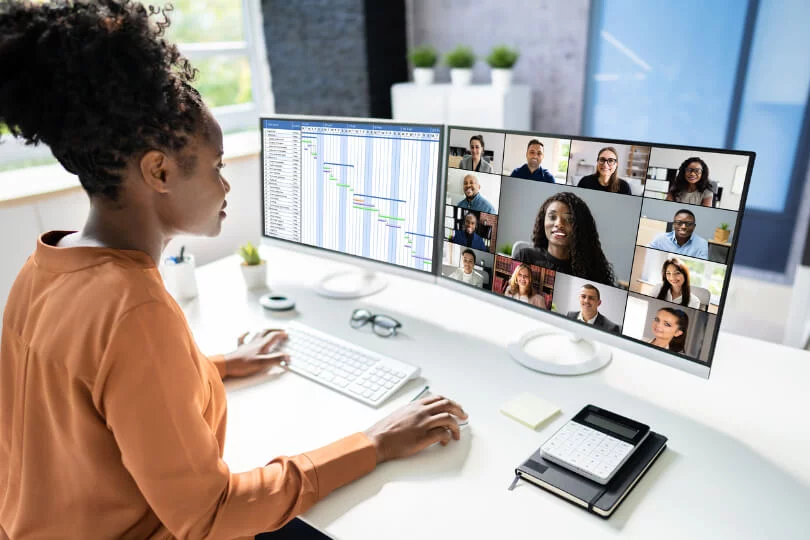Over the past few years, remote work has transitioned from being a rare perk to a mainstay of the modern workforce. As businesses continue to adapt to new ways of working, technology has been the driving force behind the shift toward more flexible and efficient remote work setups. This transformation has reshaped the concept of the office, leading to a new era of hybrid and fully remote work environments.
In this blog post, we’ll explore how technology is shaping the future of the office and what that means for employees, businesses, and the workforce as a whole.
1. The Evolution of Remote Work Tools
At the heart of the remote work revolution is a suite of technologies that make it easier than ever for teams to collaborate and communicate, no matter where they are in the world. Here are some of the essential tools that have transformed the workplace:
- Communication Platforms: Tools like Zoom, Microsoft Teams, and Slack have become everyday staples for keeping in touch with colleagues. These platforms offer video conferencing, instant messaging, and file-sharing capabilities, allowing teams to interact as if they were sitting next to each other.
- Cloud Collaboration: Cloud-based platforms like Google Workspace, Microsoft 365, and Dropbox have made document sharing and collaboration seamless. Whether it’s creating a presentation, editing a report, or managing a project, cloud tools enable multiple people to work on the same document in real-time, reducing the need for back-and-forth emails and physical meetings.
- Project Management Tools: As remote teams are spread out, project management tools like Trello, Asana, and Monday.com help keep everyone on the same page. These platforms allow for task tracking, deadlines, and progress updates, ensuring that projects stay on track even when team members are working from different locations.
2. The Role of Artificial Intelligence in Remote Work
Artificial Intelligence (AI) is becoming increasingly integrated into remote work, providing smarter solutions to help employees and businesses optimize their productivity and efficiency. Some of the ways AI is making a difference include:
- Automation of Repetitive Tasks: AI-powered tools are helping to automate routine tasks like scheduling meetings, organizing emails, or data entry. This allows employees to focus on more creative and strategic aspects of their roles, ultimately improving job satisfaction and productivity.
- Intelligent Assistants: Virtual assistants like Siri, Google Assistant, and Amazon Alexa can help remote workers stay organized by setting reminders, managing tasks, and even controlling smart home devices. These AI assistants can handle simple tasks that would otherwise distract from important work.
- Data Analytics: AI-driven analytics platforms help businesses track and analyze employee performance, identify trends, and predict future outcomes. These insights enable businesses to make data-driven decisions, whether it’s improving team efficiency or refining marketing strategies.
3. Virtual Offices and the Metaverse
As companies shift to hybrid or fully remote work, some are exploring the idea of creating virtual offices where employees can interact in a more immersive, digital space. The concept of the metaverse—a collective virtual shared space—has been gaining traction as a potential replacement for traditional office environments.
- Virtual Reality (VR) and Augmented Reality (AR): VR and AR are already being used by some companies to simulate an office environment. Platforms like Spatial and Engage are creating virtual meeting rooms where employees can interact with one another using avatars, offering a more immersive and personal experience than traditional video conferencing.
- Collaborative Virtual Spaces: Tools like Gather and Virbela are transforming how teams collaborate in a virtual environment. These platforms create customizable virtual spaces where employees can “walk” around, interact with colleagues, and attend meetings, providing a more natural, engaging alternative to the static video call.
4. Cybersecurity and Data Protection
With remote work, businesses must also rethink their approach to cybersecurity. When employees are accessing company systems from various locations, ensuring that sensitive data remains protected becomes a top priority.
- VPNs and Encryption: Virtual Private Networks (VPNs) and end-to-end encryption technologies help protect company data and ensure secure communication channels, even when working outside the office. These tools are critical for safeguarding private information and maintaining confidentiality.
- Multi-Factor Authentication (MFA): MFA is now more widely adopted as a security measure to ensure that only authorized personnel have access to company systems. By requiring multiple forms of verification (e.g., a password plus a fingerprint scan or a code sent to your phone), MFA adds an extra layer of protection.
- Endpoint Security: With employees using personal devices for work, businesses need to implement strong endpoint security. This includes ensuring that laptops, tablets, and smartphones are equipped with antivirus software and security patches to prevent unauthorized access or cyberattacks.
5. Hybrid Work: The Best of Both Worlds?
As the pandemic demonstrated, many workers can be just as productive from home as they are in the office. However, not everyone is fully comfortable with remote work, and some prefer the structure and social interaction that comes with being physically present in the office.
Hybrid work models, which combine both remote and in-office work, are becoming increasingly popular. Companies can offer flexibility by allowing employees to work from home part-time and come into the office for meetings, team-building activities, or brainstorming sessions. This setup helps retain the benefits of remote work while also fostering a sense of community and collaboration that can sometimes be lost in a fully remote environment.
Technology plays a key role in making hybrid work successful. Tools like shared calendars, virtual meeting spaces, and collaborative platforms allow remote and in-office workers to seamlessly interact and collaborate.
6. The Future of Workspaces
The rise of remote work has also led to a reimagining of physical office spaces. Many companies are downsizing their office spaces or redesigning them to accommodate hybrid work arrangements.
- Hot-desking and Co-working Spaces: Offices are moving away from traditional desk setups and adopting flexible workspaces where employees can reserve desks or meeting rooms as needed. Co-working spaces, which offer short-term rentals of office space, are becoming more popular as well, especially for freelancers and small businesses.
- Desk-less Offices: Some companies are even exploring “desk-less” offices where employees come in for meetings, collaborate in group spaces, and use communal workstations rather than having a permanent desk. This flexibility allows for better use of office space and promotes a dynamic working environment.
Conclusion: A Changing Landscape
The rise of remote work is here to stay, and technology will continue to play a major role in shaping the future of the office. From cloud collaboration tools and AI-driven productivity boosters to virtual offices and more secure remote work setups, the technology we use today is paving the way for a more flexible, connected, and efficient workforce tomorrow.
As businesses continue to embrace these new technologies, it’s clear that the future of work is no longer tied to a specific location—it’s about creating an environment that empowers employees to do their best work, wherever they are.


